In its century-plus of existence, over a billion travelers have traversed the hallowed halls of Grand Central Terminal. But how many of that intrepid number, as they gazed up at the magnificence of the constellations overhead, knew that the ceiling held a secret? I’m not talking about how the constellations are “backward”—doesn’t everybody know that? Nor am I referring to the fact that the ceiling today is not the original fresco from when the Terminal opened its doors. No, I’m talking about the secret signatures that span the mural, encircling stars and hiding inside the appendages of the towering beasts above.
Hardly known until Grand Central’s restoration in the 1990’s—and rarely talked about since—many simply assumed that only a select few individuals who had the chance to traipse across sky-high scaffolding would ever gaze upon these signatures 116 feet above the floor. In reality, the full-frame 45 megapixel Canon R5 coupled with an RF 100-500mm lens is sufficiently capable of capturing much of the approximately two inch tall hidden writing, when wielded by a photographer with a will to search the stars!
But why are there any names up there to begin with, and to whom do they belong? For the answers to those questions, we must delve into the backstory of artist Charles Gulbrandsen…

A feature that interested me was the use of small dots, no bigger than a silver dollar, of almost neutral coloring. I said, “Nobody on the floor of the concourse, even with binoculars, could see these dots. Why did you put them here?”
—Charles B. Driscoll recounts of a conversation with Charles Gulbrandsen while touring the sky mural high above Grand Central. Neither the dots nor the signatures were ever intended to be seen from the floor.
Enter Charles Gustave Gulbrandsen
Born in Brooklyn on December 3, 1890 to Norwegian immigrant parents, Charles Gustave Gulbrandsen grew up surrounded by music and art, and family members of considerable creative talent. Charles found a love in painting, commencing with an early career in creating murals, and in his later years designing scenery for theatrical sets, and for television. As an apprentice at Hewlett-Basing Studio, Gulbrandsen played a small part in the creation of the first celestial mural above Grand Central’s main concourse.
Grand Central’s original skylight concept, and the constellations that we actually got.
Originally conceived to be a skylight, both timing and financial constraints led to the alternate concept of a fresco night sky. While much of Grand Central was strong and built to last, perhaps the fact that the ceiling was a bit of an afterthought ultimately led to a less sturdy construction. No matter the cause, it did not take long for the ceiling to begin leaking. Just over a decade later, it had deteriorated to the point of being an eyesore—seeping water had left cracks, streaks, and mold. New York Central executives approached artists for replacement ideas, including Robert Winthrop Chanler, who envisioned a more fantastic starry sky, albeit even less astronomically accurate. Despite these plans the cost of a replacement would be high, and thus no action would be taken for nearly twenty more years.
By the 1940s wartime railroad traffic was booming, and Grand Central set records year after year for visitors passing through. Railroad officials began to have serious fears that the Terminal’s corroded sky was more than simply a cosmetic issue—were any plaster to fall from above it could cause grievous injury. Ultimately, Charles Gulbrandsen was recalled to redo the ceiling, this time as the primary artist. By this time he had worked on several other noteworthy murals, including the ten in the National Newark Building, the Daughters of the American Revolution’s Constitution Hall, and Cornell’s Willard Straight Hall.

Though there was debate about whether the ceiling should be made “correct”—placing the constellations in their appropriate places, and not flipped—Gulbrandsen was set on a near-faithful recreation of the original. Some may have called the work a restoration, but in reality it was a complete do-over. Using large sheets of four foot by sixteen foot tracing paper, details from the original mural were transferred to the new surface—a one-eighth inch thick layer of pressed asbestos board. Then Gulbrandsen, along with five assistants, repainted the entirety of the mural in oil paints. The original mural had taken a year to create, while the recreation took about half that time, the majority of which consisted of bolting the steel rod scaffolding directly to the ceiling girders, and fastening the new board above the old plaster.

The ceiling is decoration, not a map. The constellations are north. They should be south. So what?
—Charles Gulbrandsen on the design of the sky ceiling, 1944. According to Gulbrandsen, the initial reversal was an intentional artistic choice, adapting a subject matter more suitable for a dome onto the Terminal’s barrel-vault configuration.
In total, the painting work took only ten weeks. As new constellations came to life, friends and family members were often invited up onto the scaffolding by Gulbrandsen to get an up-close look at the work going on. Many of the visitors picked a spot to leave their mark, signing their names or other messages for posterity, all invisible to the naked eye of the millions of travelers far below. Even today you can find the names of Gulbrandsen’s eldest children, his wife, several friends, railroad employees, reporters, and others scattered across the vast space of the sky. And when the ceiling was restored in the 1990s, several added to the tradition, including conservator John Canning, whose company worked to clear the grime away.

During the pandemic, finding the names hidden in the sky became a minor obsession for me. I started with the only location I had ever heard mentioned previously—J.V. Brophy’s name hidden in the eye of Pegasus. From there, I was able to determine that my camera, with its super telephoto lens and additional digital zooming, could actually capture the names. The next step was simply to search—I snapped photos of the constellations, merged them in Photoshop, and looked for “abnormalities” in the super-high resolution images. When you ignored all the other details that were too small to see from the ground, like the round holes that the original scaffolding was mounted through, the large staples fastening the boards to the ceiling, and the random streaks of dirt, you’d often find someone’s personal mark.
There was considerable excitement in finding a name, which quickly turned to curiosity. Who were these people, and why were their names there at all? Throughout the journey I learned a lot about an entire clan of talented artists and musicians, became well acquainted with the frustration of not being able to figure out who everyone was, and experienced a profound sadness for a young man whose life was tragically cut short very soon after signing his name in the heavens. It was uniquely exhilarating to find how these people fit into the larger puzzle, and especially so when I sighted the name of an artist whose name I recognized, who likely signed their name while capturing a famous photograph.
The next time you are in Grand Central, look up! There are secrets in the stars, and I am confident that I did not discover them all…

Cancer
Starting off at the northwest end of the Terminal’s ceiling (which would realistically be in the southeast, if the constellations were not reversed) is Cancer, the crab. Look to the right claw and you’ll find two sets of names, one surrounding the star Tegmen, and the other at the claw’s very tip.
1. Moses & Marguerite Harris
Born in 1899 in Brooklyn, Marguerite Harris is remembered as a talented “force of nature.” Leaving home at age fourteen to escape her staunchly religious parents, Marguerite became the assistant to Geoffrey Scott, editor of The Boswell Diaries. With a keen eye for art, Marguerite ran several art galleries in Los Angeles and New York City, including the “Ten Dollar Gallery,” where every painting cost just that amount (after the Great Depression, it became the “Twenty Dollar Gallery”). She was married several times, notably to film producer Sam Zimbalist, from whom she separated around 1940. After returning to New York, she married Moses Harris, and became known as a successful poet and editor. She founded the poetry journal Wand, was a force behind the Woodstock Poetry Festival, and was a recipient of the Edwin Markham Prize for Poetry.
2. 1997 All For Thomas & Jarett
I wasn’t able to track down who Thomas and Jarrett were, but someone wrote their names up on the ceiling of Cancer’s right claw during the restoration of the mural in the 90’s. If you’re ever looking for a signature to spot, this is the brightest and largest, so it would be my first recommendation to beginning ceiling stargazers.
Gemini
Following along the line of the ecliptic (the path of the sun through the stars), the next constellation we arrive at is Gemini, the twins. At least two signatures can be found within.
Orion
Moving on is Orion, the hunter, just below the ecliptic, and the only constellation to not be reversed. Signatures can be found in several of the constellation’s major stars, including Rigel (in the hunter’s foot) and Betelgeuse (in the shoulder). Passing through the bottom of the constellation is the celestial equator, a projection of the Earth’s equator into the sky.
3. Ingrid Gulbrandsen
Born on November 8th 1890 in Arendal, Norway, Ingrid Lovold was a talented pianist that was educated in Belgium. She met Charles Gulbrandsen shortly after emigrating to the United States, and they wed in 1911. Together they had five children, including three whose names can be found on Grand Central’s ceiling.
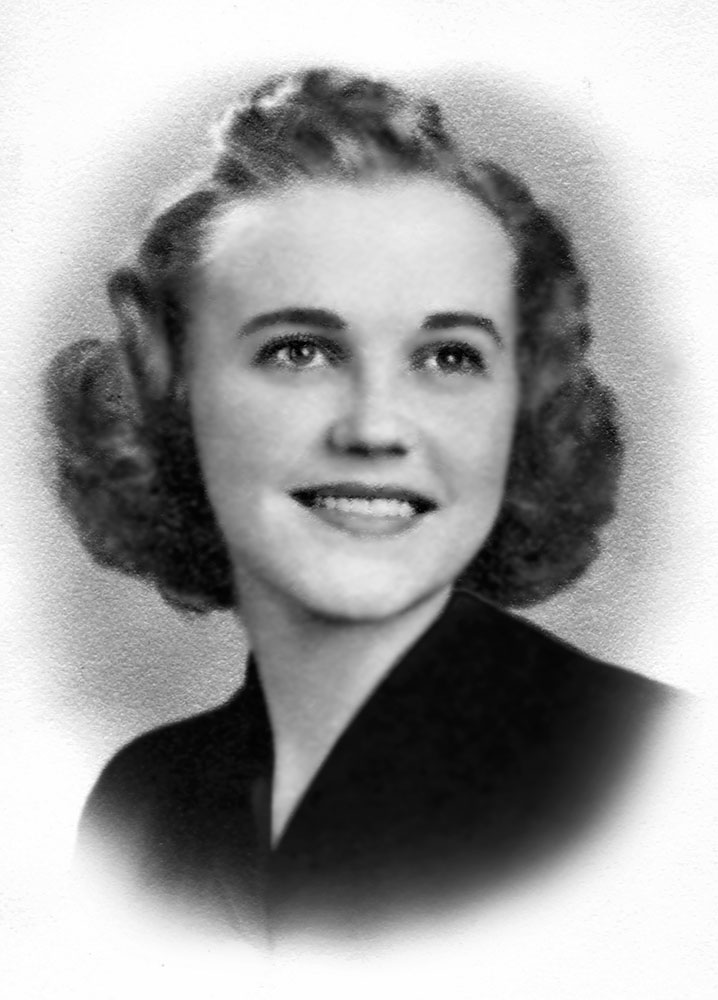
5. Alfhild Engborg
Born in 1916, Alfhild Gulbrandsen was the second child of Charles and Ingrid Gulbrandsen. She grew up playing the piano and singing, and later attended the Packard School for Business to train as a secretary. Shortly before her name was written here, she married Arvid Robert Engborg.
Engborg held various jobs as a secretary throughout her life, including at the publishing house Doubleday, and was later a customer service representative for Sears Roebuck. She continued to play the piano throughout her life, and was remembered for other creative pursuits, including dressmaking.
Taurus
Next along the ecliptic is Taurus, the bull. Many signers chose stars for their marks, and here is no different. You will find names around the notable stars Elnath (tip of the horn) and Aldebaran (in the bull’s face), along with several others.

2. Lt. H.C. Allington Jr. & Marge Allington
Born in Tarrytown on October 27, 1924, Homer Clifford Allington grew up in Binghamton, and later Port Washington, New York. Through his high school days he was known as “Sug†and was President of the Fratry, the local boy’s service organization. Although short in stature, Allington was a lover of sports (except badminton), and worked on beefing up his muscles by doing the Charles Atlas workout, with the hopes of joining the Navy Air Corps.
Allington instead became a member of the Army Air Forces, and was stationed in Guam as part of the 19th Bombardment Group. He took part in the firebombing of Tokyo in March of 1945, where he was the bombardier aboard B-29 Zero Auer. Shot down by anti aircraft fire, the plane crashed in Kawaguchi City, just north of Tokyo.
Shortly before shipping out, Allington scrawled his and his mother’s name around Zeta Tauri, the star at the tip of Taurus’s right horn. Decades later, it is a memory of one of many young people lost too soon during a brutal World War.
Allington was linked to the Gulbrandsen clan by his elder sister Helen, who married Charles Frithjof.
3. Charles B. Driscoll, New York Day By Day, 1945
Charles Benedict Driscoll, born October 19, 1885 in Wichita, Kansas, was an author of Irish descent, penning the book “Kansas Irish” about his Irish-born father’s life after immigrating to the United States. He worked as a newspaper reporter and editor, and was the author of the column “New York Day by Day” from 1938 until his death in 1951.
Driscoll was given a tour of the work by Charles Gulbrandsen himself, describing the work in the New York Day by Day column which appeared on June 6, 1945.

4. Signe Fay
Born in 1914, Signe Gulbrandsen was Charles and Ingrid’s first child. A talented lyric soprano, she received scholarships to the Curtis Institute of Philadelphia and the Julliard School of Music. As a professional vocalist Gulbrandsen appeared in many concerts in New York and New Jersey, and sang with the Knoxville Symphony Orchestra in 1937. She appeared on Broadway as Mary in the play “Captain Jinks of the Horse Marines” in 1938, and one year later married Thomas Bernard Fay.
Musca & Triangulum
Further along the ecliptic we pass Aries (the ram), where I did not find any names, and reach the constellations of Musca, Triangulum, and the deprecated Triangulum Minus. Several signatures can be found throughout this group.
Gulbrandsen’s extra triangle
Although not a signature per se, I was unable to find any actual signature by of the artist himself. That being said, the second triangle in Triangulum is a departure from the original mural. Intended to be a faithful reproduction of the original, why was a second triangle added? Perhaps it was a special way for Gulbrandsen to leave his own mark.
As a constellation, Triangulum Minus is considered obsolete, and no longer recognized as an official constellation.

6. E. Nowak
Edwin Stanley Nowak was born on April 18, 1918 in Wyoming County, New York, and grew up in Rochester. Throughout his youth he photographed with a Kodak Brownie, developing his negatives at home. After a short stint studying chemical engineering at the University of Michigan, Nowak landed a lucrative job testing photographic film at Kodak, never returning to finish his degree. Alas, laboratory work left young Nowak unfulfilled, and he took a pay cut to work at a local photography studio.
The allure of more interesting and well-paying photography work lured Nowak to New York City, where he found jobs in the fashion industry and taught darkroom technique at the School of Modern Photography. He persuaded the New York Central Railroad to hire him, and served as the company’s on-staff full-time photographer until 1954, and later on a contract basis. Nowak’s body of work provides an impressive look at the final heyday of a great American railroad.
Later in life Nowak moved to Fort Myers, Florida, where he passed away on January 13, 2002.

We know that Nowak climbed atop the scaffolding in December of 1944 to capture this image—perhaps it was then he also left his name along Musca’s front leg.
Pisces
Next along the ecliptic is Pisces, two connected fishes. Look to their starry eyes, which hold the signatures we are seeking.
3. W. E. Gallaher, Hudson Cond.
William Edwin Gallaher was born in 1908 in Crugers, New York and died in 1992. He worked for the New York Central Railroad as a conductor on the Hudson Division. On his World War II draft card he lists Irvington as his place of residence, and Grand Central’s Room 1612 as his place of employment.
Pegasus
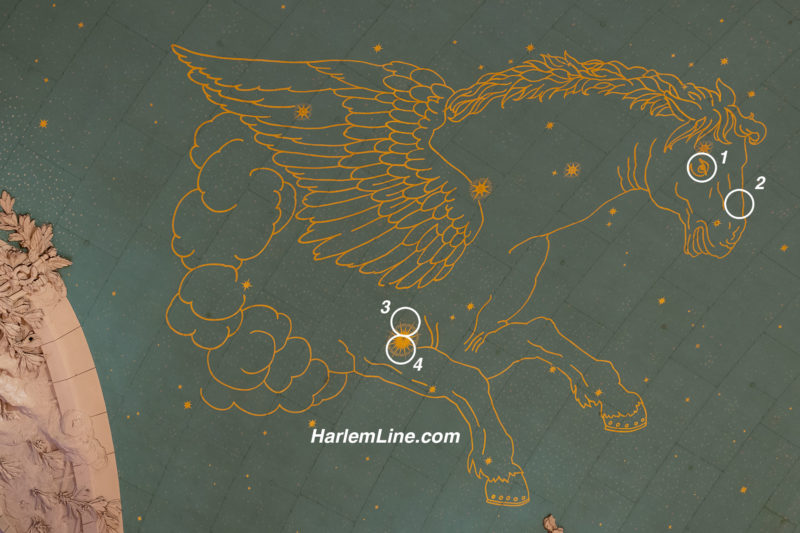
The last constellation along the ecliptic is Aquarius (the water carrier), alas I did not find any signatures there, so we pass along to the opposite corner of the mural, where you will find Pegasus. Notable star Scheat, or Beta Pegasi, holds a total of four names, two along the top, and two more along the bottom.
2. Edwin C. Hafker
Edwin Charles Hafker of Port Chester, New York. Born July 8, 1908. Hafker worked as a carpenter for Percy L. Smith Builders of Scarsdale. Died September 2, 1996.
Close to Hafker’s name is another bit of writing, but I was unable to decipher it. Perhaps you may be able to make a discovery of your own right here!

3. “Bub” & Helen Gulbrandsen
According to Gulbrandsen family lore, this was written by the elder Charles in celebration of the nuptials of his son Charles Frithjof Gulbrandsen – “Bub†and Helen Welte Allington.
Charles Frithjof was born September 7, 1920, attended St. Lawrence University after the war, and worked for IBM on Madison Avenue in Manhattan.

4. Mike DeLuco, John Canning, 1996
John Canning is a graduate of the Glasgow Stow College of Building, the Scottish Decorative Trades Institute, and the Glasgow School of Art. He emigrated to the United States in the early ’70s, and established a studio focusing on historic preservation in Cheshire, Connecticut. Some of the studio’s early projects included restoration work at Yale University and Connecticut’s state capitol building. The company was selected to work on Grand Central Terminal’s ceiling as part of the larger restoration efforts in the late ’90s under Beyer Blinder Belle.
Michael Albert DeLuco is a painter originally from Maine that has worked for John Canning’s company since 1987. He worked as a restorer on Grand Central’s ceiling in 1996 and 1997.
Hopefully, the above information will provide the next stargazers a place to begin their own journeys. Know some information about any of the people above, or find something new on the ceiling yourself? Drop me a line or comment below, and I’ll keep this list updated!
Special thanks to Amanda Murphy, great granddaughter of Charles Gulbrandsen, who provided photos and information for this article. Additional family photos were accessed through Ancestry family trees.







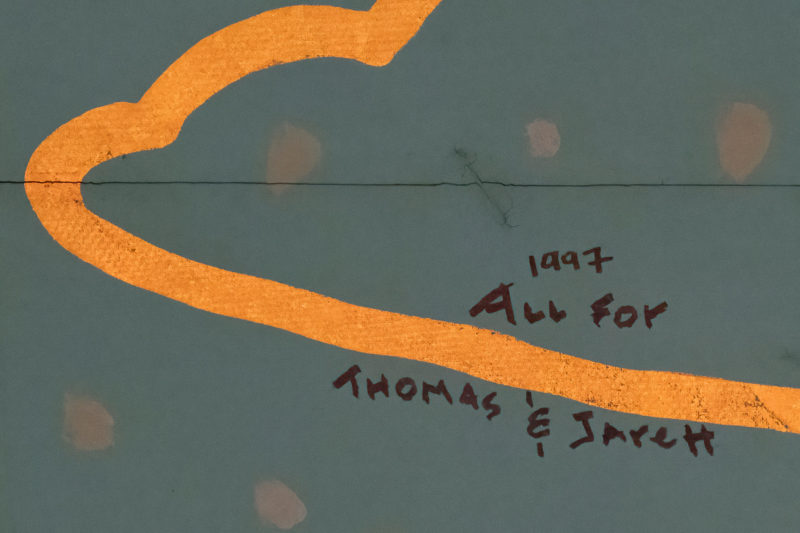


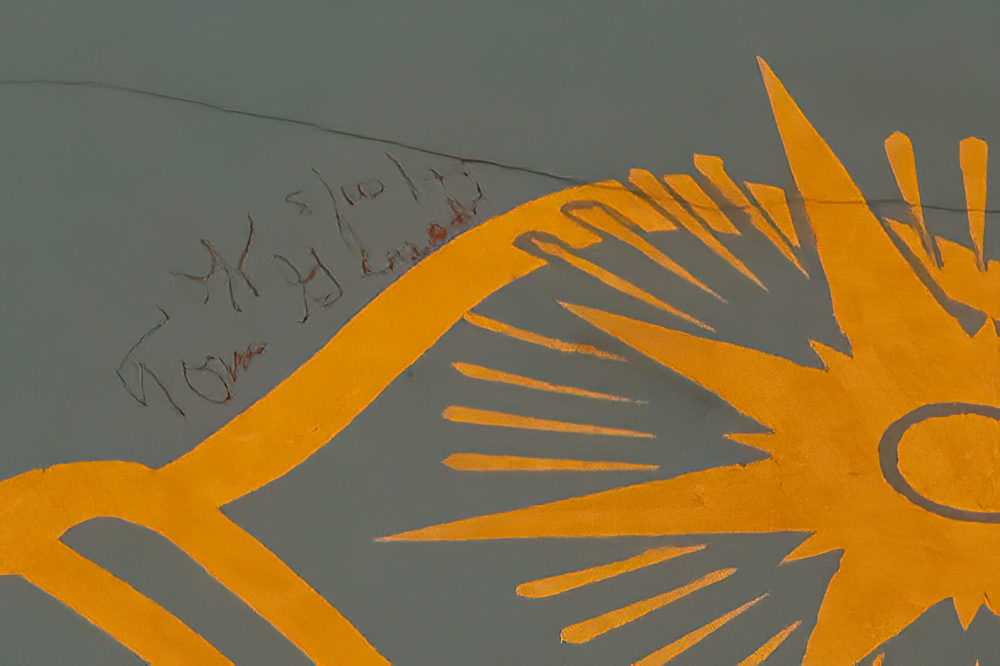












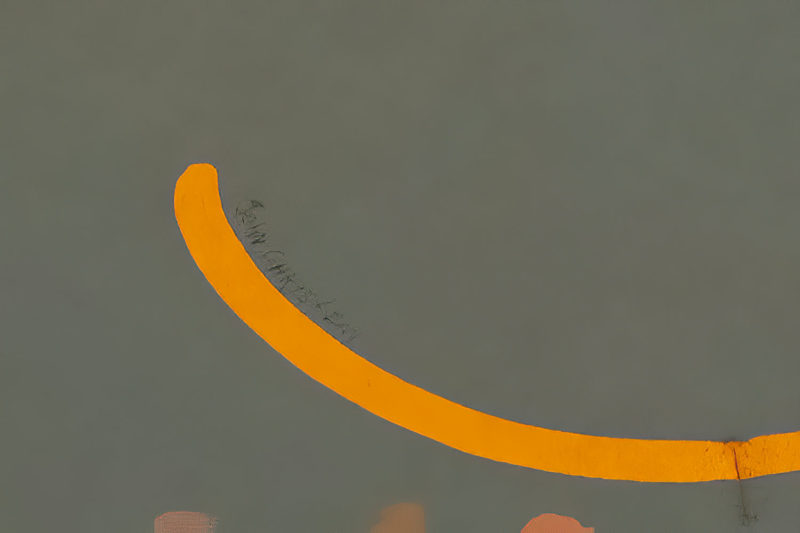
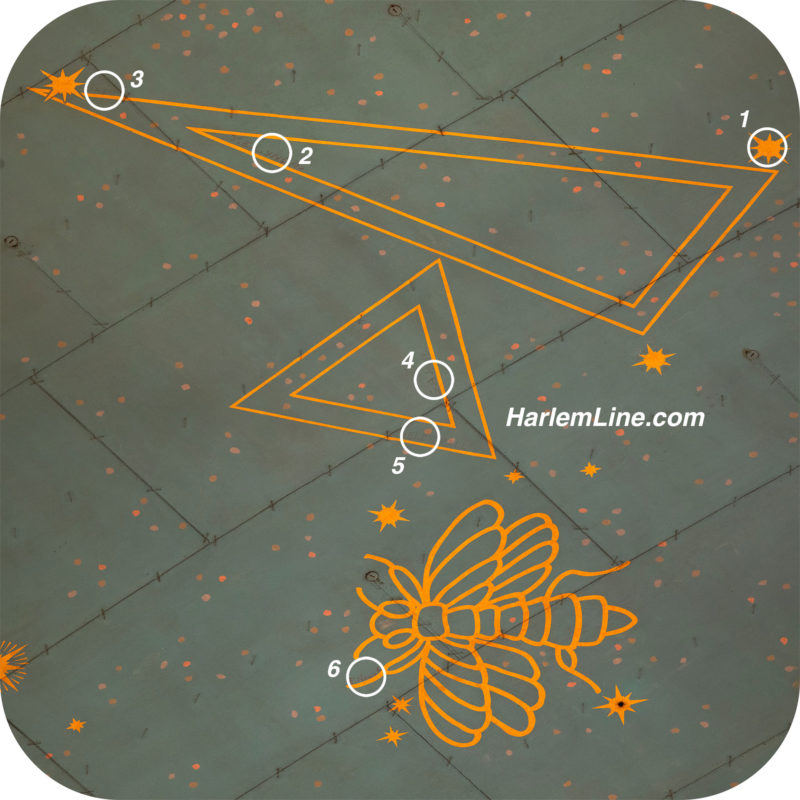


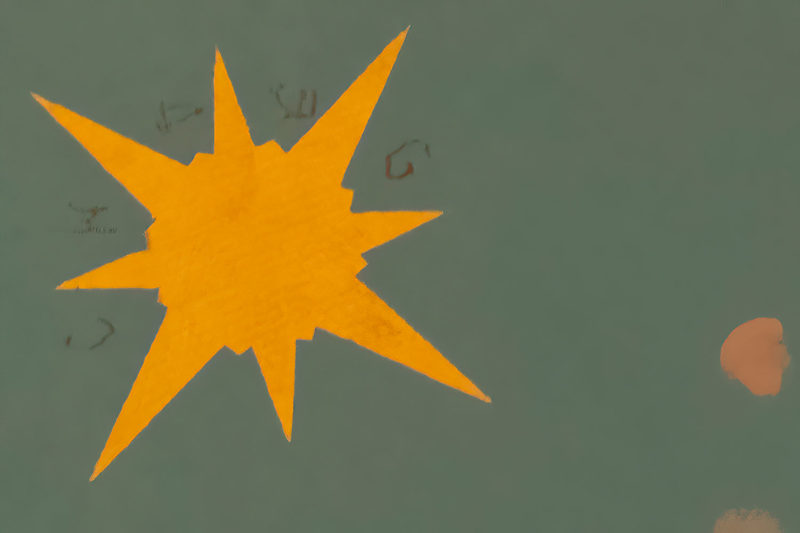
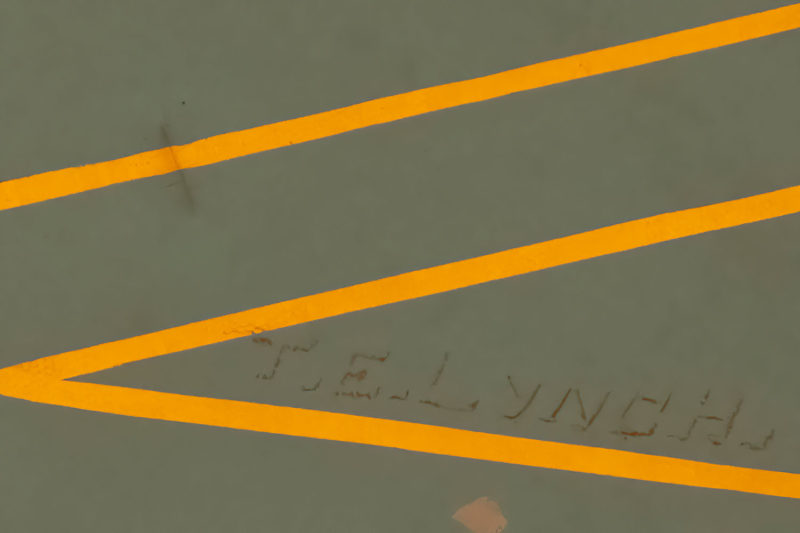

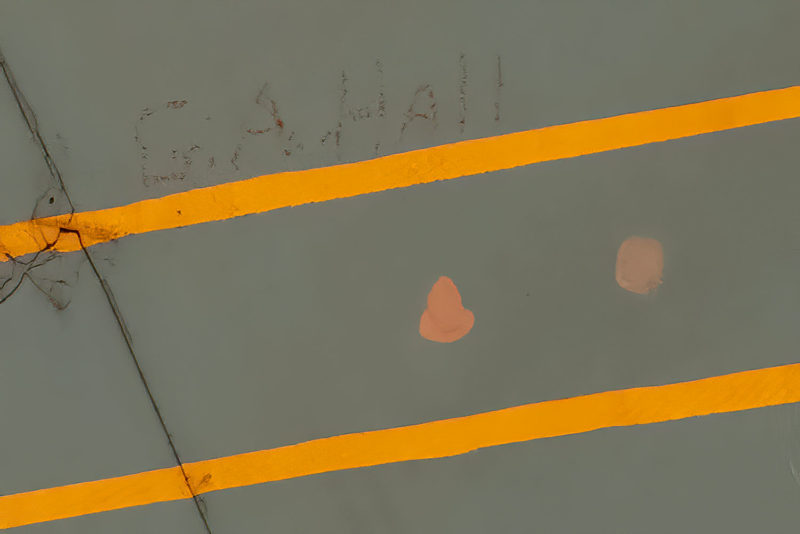


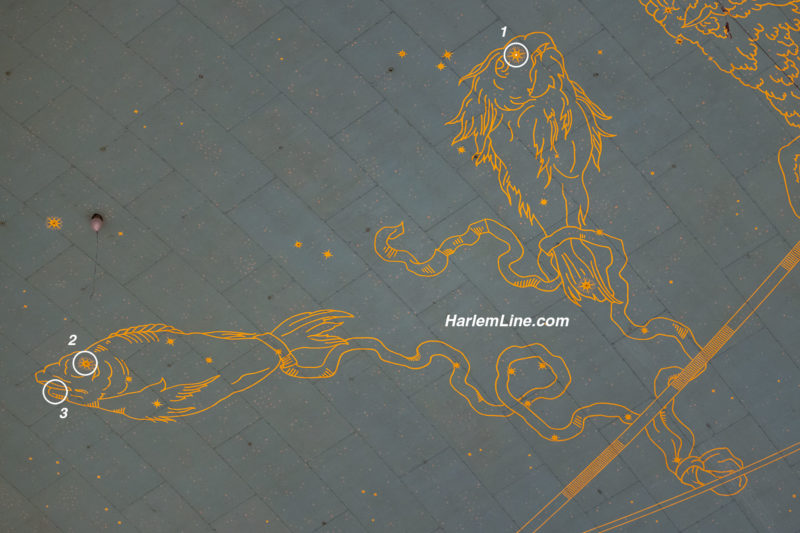



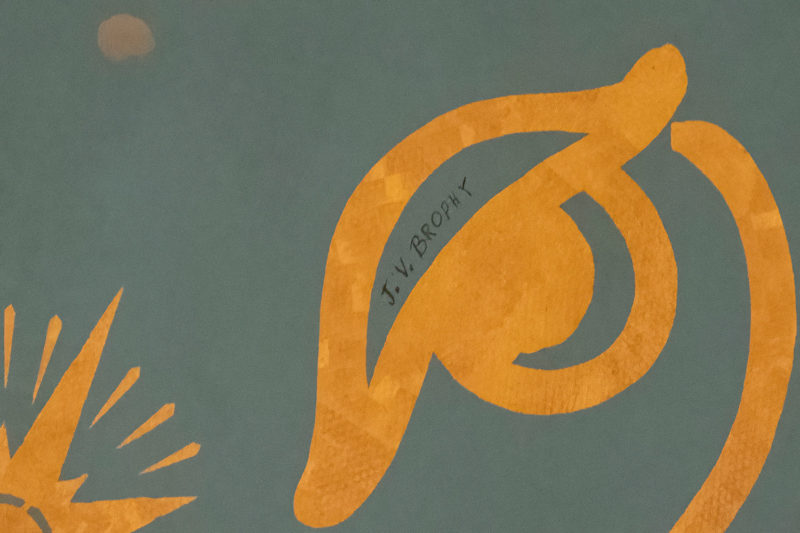

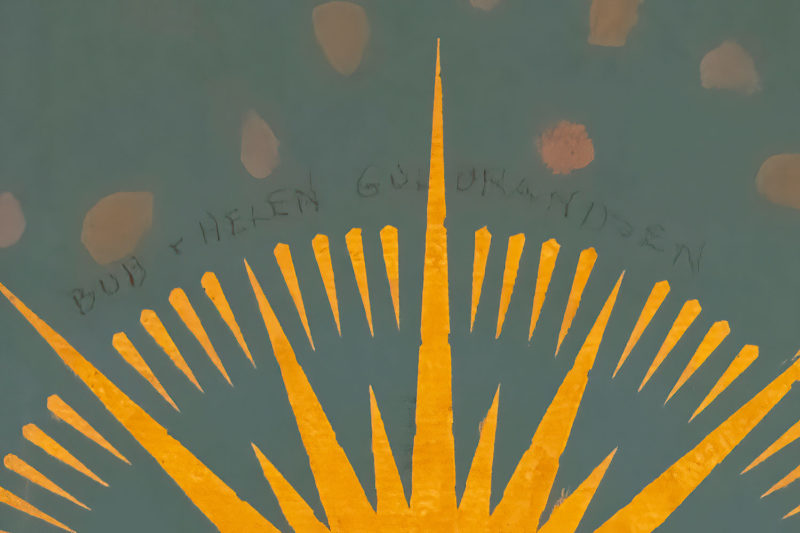

Fantastic research. Thank you for this!
Alot of names inside the clock, unfortunately not old, mostly new and predominantly state troopers.
Wow. Very interesting.
So exciting to see just where those family names are. Lots of good stories about them growing up!
Ok, this is a year later, but the New York Transit Museum store announced umbrellas with the GCT constellations on them.
https://www.nytransitmuseumstore.com/
Wow i just stumbled onto this article. I am Mike “duluco’ Lol .And i did not sign that.Most likely it was my boss that signed my name there as he had/has a reputation for butchering names. I also did sign my own name in another spot though
Haha, so where did you really sign your name? :D
Thanks for your research! June Allington Archer was the sister of my mother, Helen Welte Allington, who married Charles F. Gulbrandsen in 1944. June married Lawrence John Archer in 1944. The couple lived in Port Washington, NY.
This is fascinating info Emily! Thanks for the deep dive. Have you heard that there are messages as well as signatures in the ceiling? I’ve heard that near Gemini there is a celebratory message about the birth of twins and also a mention of D-Day somewhere else in the ceiling. Is there any truth to this or are they GCT myths?
Thanks!